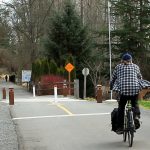Living as I do now in the land of technology, aka Seattle, I assume I’m surrounded 24/7/365 by people thinking up new ways to give me new tools to be “more productive,” all of which will involve giving some of my attention to glowing electrons.
I’ve always loved to read and even that now involves technology, which in turn requires maintenance. (All my neatly organized collections on my Kindle mysteriously vanished and had to be recreated just the other day, turning reading into work when it’s supposed to be relaxing.)
Couple all this tech stuff with my lifelong tendency to say yes to lots of things and then generate ideas to turn them into even more work and you have yourself a recipe for burnout.
Biking can be a discipline to which you bring all the compulsive over-achieving, data analysis, and tech whiz-bang possible. (I know this because I’m married to someone who trains for bike racing.)
Fortunately for me, I’ve outgrown some of the Western world’s thinking about athletic achievement thanks to a yoga practice of several years. In yoga, where you are in your practice is where you are. Force it and you’ll snap a hamstring (which makes a sound like a rifle shot, as I know from painful firsthand experience).
Settle into your practice, though, instead of striving constantly for “more” and “should” and “better” and “perfect”; bring everything you have into that moment; and you will have a deeply satisfying experience that uses every cell and fiber in your body. And you do improve so that ambition thing gets satisfied eventually.
Biking is much the same way. Like yoga, bicycling provides a wonderful practice opportunity for mindfulness meditation, as Puget Sound area biking blogger Claire Petersky has pointed out.
[Tweet “Riding in traffic is particularly good for biking mindfulness.”]
Riding in traffic is particularly good for biking mindfulness. If you’re riding with the flow of traffic you’re constantly adjusting pedaling pace to maintain a safe distance as drivers and riders around you change speed.
You’re watching pedestrian movement and looking for unpredictable pets.
You’re looking for cracks, potholes, broken glass, gravel (which gave me a nasty fall a couple of weeks ago), slippery sewer access covers, stormwater grates that have the openings running parallel to your tires so you have to avoid them….
Despite what Kevin Henderson said about ESP, I still have to look.
At the same time you’re feeling the power of your own muscles moving you forward, the breeze in your face. You’re taking in the smells, sights, and sounds of things around you and gauging the weather and its potential effects on your riding. If it rains you have to brake sooner than normal. If it’s hot you need to drink more water. Your chain is starting to make that chirping sound that indicates you need to lube it.
This may sound like a lot of input. But compare it to a workday with ringing phones, people coming into your office with questions, the email notice blooming constantly in the corner of your monitor, texting teenagers asking if they can have a friend over and bake cookies and by the way where do you keep the vanilla, a dozen or more tabs open in your browser.
I have two monitors at work plus my tablet and on some days a laptop. Think about how much real estate I have in which to create screens full of competing projects: five or six if you count my cell phone (you should) and the screen on my desk phone with its annoying little note about missed calls.
Paying attention to only one purpose — riding my bike — instead of dealing with multiple purposes and priorities is incredibly relaxing by comparison.
When I ride my bike I’m completely in the moment. At the same time I have created a space in which I cannot be distracted by electronic technology, thus improving my ability to focus. Much as it may amaze some of my online acquaintances to realize this, I do not actually tweet every five minutes.
Around 50% of all car trips in the U.S. are three miles or less. This is ridiculously short — the engine doesn’t even warm up. But on a bike that distance takes about 15 minutes, a wonderful length of time that lets you clear your head and make some space in your life.
Biking is downtime, a precious commodity in our plugged-in, wired, always-on world. Make some time for downtime.
[Tweet “Biking is downtime, a precious commodity. Make some time for downtime.”]
A version of this post originally appeared on my personal bike blog, Bike Style Life.
Related Reading
Your Turn
- What does riding your bike do for your mental health and ability to focus?
- When was the last time you deliberately scheduled (yes, scheduled) downtime?





One Comment
Great observations concerning the mental aspects of bike riding Barb. Having spent over 20 years bicycle commuting fairly consistently, I can attest to the concentrated focus and elimination of distractions occasionally necessary during high car traffic urban bike commuting. This living in the moment, full command of ones attention, is also required during certain kinds of other cycling, most notably mountain biking.
However, my bike commutes always consisted of a mixture of high traffic urban sections and minimal traffic bike paths (mostly consisting of the occasional fellow rider or rabbits scurrying across the path). During these sections the mind can wander and I often found myself with the distraction free time for more creative thinking and idea generation.
Interesting how the bicycle offers these very different positive mental aspects, along with the obvious physical, economic and community benefits.